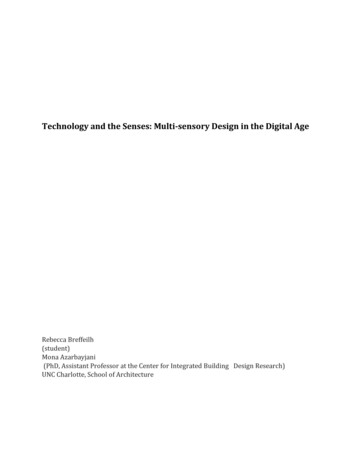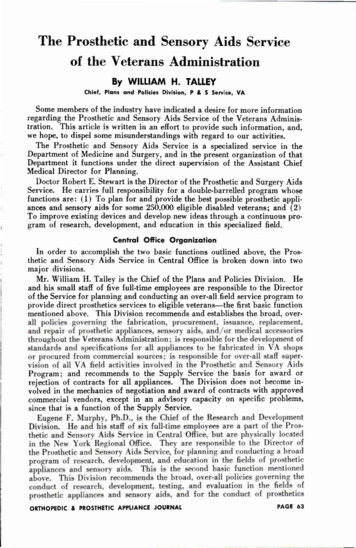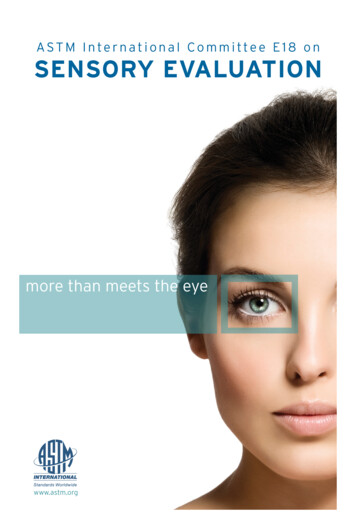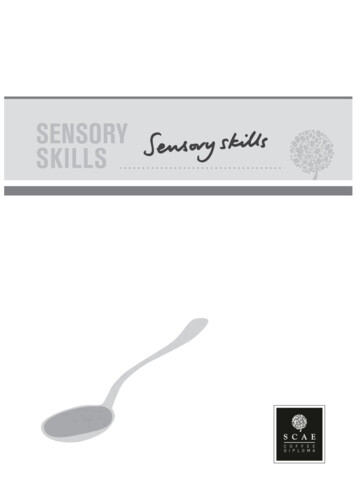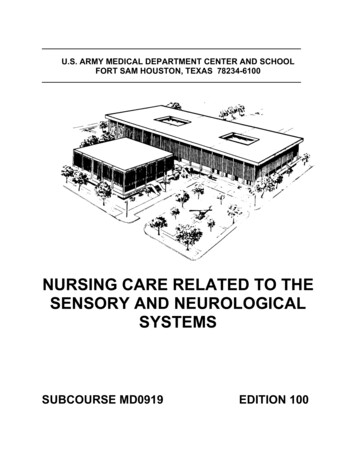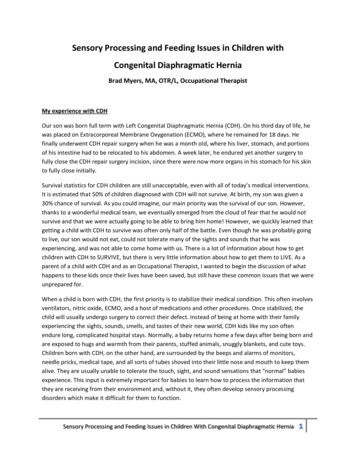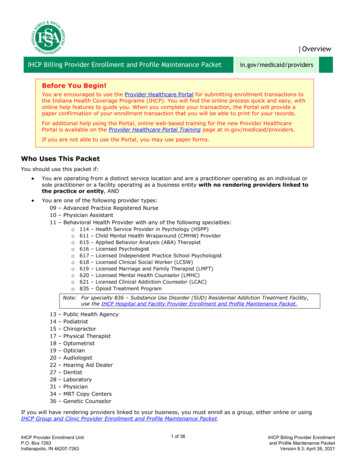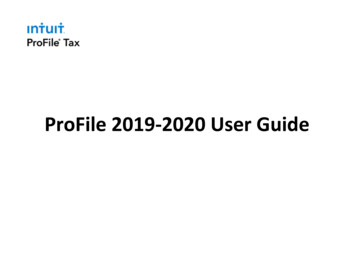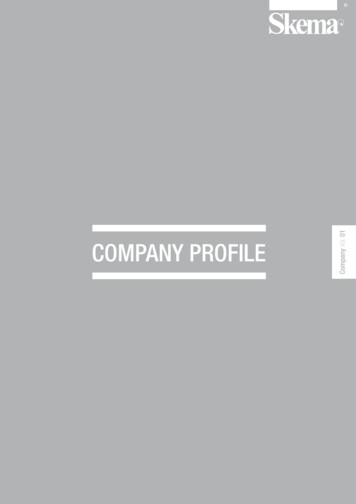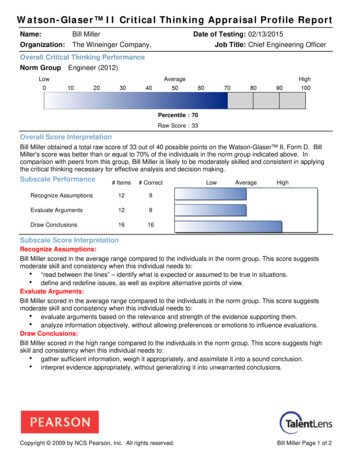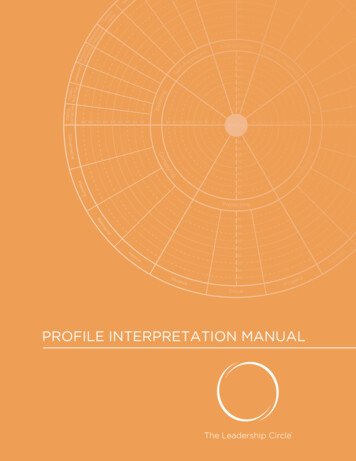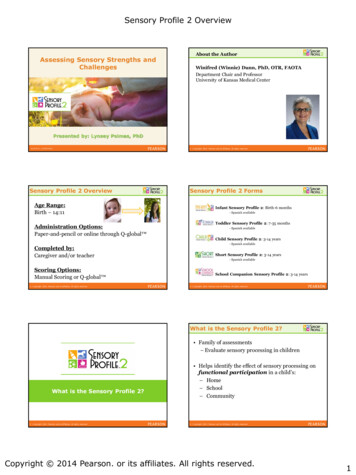
Transcription
Sensory Profile 2 OverviewAssessing Sensory Strengths andChallengesAbout the AuthorWinifred (Winnie) Dunn, PhD, OTR, FAOTADepartment Chair and ProfessorUniversity of Kansas Medical CenterPresented by: Lynsey Psimas, PhD2 Copyright 2014. Pearson and its Affiliates. All rights reservedSensory Profile 2 OverviewAge Range:Birth – 14:11Administration Options:Paper-and-pencil or online through Q-global Completed by:Caregiver and/or teacherScoring Options:Manual Scoring or Q-global 3 Copyright 2014. Pearson and its Affiliates. All rights reservedSensory Profile 2 FormsInfant Sensory Profile 2: Birth-6 months- Spanish availableToddler Sensory Profile 2: 7-35 months- Spanish availableChild Sensory Profile 2: 3-14 years- Spanish availableShort Sensory Profile 2: 3-14 years- Spanish availableSchool Companion Sensory Profile 2: 3-14 years4 Copyright 2014. Pearson and its Affiliates. All rights reservedWhat is the Sensory Profile 2? Family of assessments– Evaluate sensory processing in childrenWhat is the Sensory Profile 2?5 Copyright 2014. Pearson and its Affiliates. All rights reserved Helps identify the effect of sensory processing onfunctional participation in a child’s:– Home– School– Community6 Copyright 2014. Pearson and its Affiliates. All rights reservedCopyright 2014 Pearson. or its affiliates. All rights reserved.1
Sensory Profile 2 OverviewWhat is the Sensory Profile 2? A set of judgment-based caregiver or teacherquestionnaires. Information collected helps formulate hypotheses.Sensory Processing is NOT aunitary construct Parents and/or teachers (with regular contact withthe child) complete the questionnaire.Everyone falls somewhere on EACH continuum Patterns of responses indicate the child’s sensoryprocessing patterns.Name7 Copyright 2014. Pearson and its Affiliates. All rights reserved8 Copyright 2014. Pearson and its Affiliates. All rights reservedAppropriate Uses of SP2Added Data for Diagnoses Contribute to determining eligibility for services. Data provides information for intervention planningwithin a multi-tiered model of support. Data provides a vehicle for discussion. Data are combined with other data (ex. Siblings) NOT designed to document progress.9 Copyright 2014. Pearson and its Affiliates. All rights reserved Diagnostic and Statistical Manual of MentalDisorders (5th ed.; DSM–5) criteria for AutismSpectrum Disorder includes:– Manifestation of “hyper- or hypo-reactivity tosensory input or unusual interest in sensoryaspects of environment” (American Psychiatric Association [APA], 2013) The Sensory Profile 2 provides a data-based way todocument this criteria.10 Copyright 2014. Pearson and its Affiliates. All rights reservedSensory Profile 2: What’s New? Infant, Toddler, Child, Short, and School Companion combinedin one kit, with one manual Updated content Shorter administration time (reduced number of items exceptToddler Form)– Infant: 36 - 25– Child: 125 - 86What’s new on the SP2?– School: 62 - 44– Short: 38 - 34 Greater consistency between forms Infant and Toddler record forms now on two separate forms11 Copyright 2014. Pearson and its Affiliates. All rights reserved12 Copyright 2014. Pearson and its Affiliates. All rights reservedCopyright 2014 Pearson. or its affiliates. All rights reserved.2
Sensory Profile 2 OverviewSensory Profile 2: What’s New?Sensory Profile 2: What’s New? Ability to score online via Q-global No longer separate score sheets: Score summaryincluded on questionnaire Ability to compare responses across caregivers withnew multi-rater report in Q-global. Percentile rank added for an additional level ofanalysis Expanded upper age range to 14:11 on Child, SchoolCompanion, and Short Forms Questions were carefully reviewed to improvereadability (remove double negatives) Increased validity and reliability studies Weighting on questions: “Almost Always” 5 insteadof 113 Copyright 2014. Pearson and its Affiliates. All rights reserved14 Copyright 2014. Pearson and its Affiliates. All rights reservedExample Items & Icon KeyNew Ratings (1-5)15 Copyright 2014. Pearson and its Affiliates. All rights reserved16 Copyright 2014. Pearson and its Affiliates. All rights reserved17 Copyright 2014. Pearson and its Affiliates. All rights reserved18 Copyright 2014. Pearson and its Affiliates. All rights reservedCopyright 2014 Pearson. or its affiliates. All rights reserved.3
Sensory Profile 2 OverviewScores: Raw Score based cutscores, percentile ranges, anddescriptive categories for:1.2.3.Sensory Patterns Summary(Quadrants)Sensory and BehavioralSectionsSchool Factors (SchoolCompanion only)19 Copyright 2014. Pearson and its Affiliates. All rights reserved20 Copyright 2014. Pearson and its Affiliates. All rights reservedDunn’s Framework of Sensory ProcessingTheoretical Foundations21 Copyright 2014. Pearson and its Affiliates. All rights reserved22 Copyright 2014. Pearson and its Affiliates. All rights reservedCombination of sensory eventsSensory Sensitivity1. Sensory System Scores– General, Auditory, Visual, Touch, Movement, BodyPosition, Oral Passive response to a low threshold2. Behavioral Scores– Behavioral, Conduct, Social Emotional, Attentional3. Sensory Pattern Scores– Seeking/Seeker, Avoiding/Avoider,Sensitivity/Sensor, Registration/Bystander Easily respond to sensory stimuli Notice things other people don’t notice Highly aware of their surroundings4. School Factor Scores (School Companion only)– Supports, Awareness, Tolerance, Availability Distractible23 Copyright 2014. Pearson and its Affiliates. All rights reserved24 Copyright 2014. Pearson and its Affiliates. All rights reservedCopyright 2014 Pearson. or its affiliates. All rights reserved.4
Sensory Profile 2 OverviewSensation AvoidingLow Registration Actively counteract a low threshold Passive response with a high threshold Intentional withdrawal or blocking of sensation Miss available sensory input Use of rituals and routines Overwhelmed by sensoryrich environments Spacey, clumsy Under-responsive or slow to respond Can focus in distracting environments Good at creating structured andsupportive environments Flexible, comfortable in wide range of environments25 Copyright 2014. Pearson and its Affiliates. All rights reserved26 Copyright 2014. Pearson and its Affiliates. All rights reservedSensation Seeking Behavioral response to counteract a highthreshold Enjoys sensory rich environments Creates sensation Easily boredClinical Profiles Trouble tolerating low stimulus environments27 Copyright 2014. Pearson and its Affiliates. All rights reserved28 Copyright 2014. Pearson and its Affiliates. All rights reservedProfile: Autism/AspergerProfile: Older adults More likely to exhibit behaviors in:– Sensation seeking, low registration, and sensorysensitivity Low scores on Sensation Seeking High scores on Low Registration with cumulativelyhigher scores as people age from 60 – 70 – 80. Especially sensitive to auditory and oral motor input29 Copyright 2014. Pearson and its Affiliates. All rights reserved30 Copyright 2014. Pearson and its Affiliates. All rights reservedCopyright 2014 Pearson. or its affiliates. All rights reserved.5
Sensory Profile 2 OverviewAttention Deficit Hyperactivity Disorder Differences across all quadrants May be more reflective of a modulation problemScoring the Sensory Profile 231 Copyright 2014. Pearson and its Affiliates. All rights reserved32 Copyright 2014. Pearson and its Affiliates. All rights reservedCut score and Classification SystemAdministration/Scoring TimeMuchLessthanOthersMuchMorethanOthers Paper and web-based Administration– Infant Sensory Profile 2:5 to 10 minutes– Toddler Sensory Profile 2: 10 to 15 minutes– Child Sensory Profile 2:15 to 20 minutes– Short Sensory Profile 2:5 to 10 minutes– School Companion (SP2): 15 minutes Scoring– Manual Scoring: Approx. 15 minutes– Web-based administration and scoring: 0 minutes Enhanced Assessment and Planning Report– Adds approx. 15 to 30 minutes to completion time33 Copyright 2014. Pearson and its Affiliates. All rights reserved34 Copyright 2014. Pearson and its Affiliates. All rights reservedSensory Profile 2: Q-global ScoringQ-global example1. Reporting Options in Q-global:– Score Report– Item Analysis Report– Assessment & Planning Report Helps determine next-steps based on results– Multi-rater Report2. Administration Options in Q-global:– Ability to administer on-screen in the office, or remotelyby sending a link by email through Q-globalWWW.HELLOQ.COM35 Copyright 2014. Pearson and its Affiliates. All rights reserved36 Copyright 2014. Pearson and its Affiliates. All rights reservedCopyright 2014 Pearson. or its affiliates. All rights reserved.6
Sensory Profile 2 OverviewNormative Information 2012-2013 – Stratified sample 1791 - Total children 337 - Children rated on both child and school forms 774 children with disabilitiesReliability and Validity Approx. 10% of sample - children with disabilities Data collected both digitally and paper/pencil37 Copyright 2014. Pearson and its Affiliates. All rights reserved38 Copyright 2014. Pearson and its Affiliates. All rights reservedReliability StudiesValidity Studies Test-Retest Reliability “Consistency of a measure from one time to another”– Caregiver .83 - .97– School .66 - .93 Previous Sensory Profiles BASC-2 PRS and SP2 Child/Short forms BASC-2 TRS and SP2 School form SSIS parent and SP2 Child form Inter-Rater Reliability “Degree to which different raters give consistentestimates of the same phenomenon”– Caregiver: Mostly in .70s and .80s– Teacher: Mostly in .70s, .80s and .90s SSIS teacher and SP2 School form Vineland-II and SP2 Infant/Toddler/Child forms School Function Assessment and SP2 School form39 Copyright 2014. Pearson and its Affiliates. All rights reserved40 Copyright 2014. Pearson and its Affiliates. All rights reservedSpanish ValidityClinical Comparison Groups Spanish caregiver forms for:– Infant– Toddler– Child– Short Discrimination for clinical groups was key for development Validation with 138 Spanish speaking families 3 summary scores with differences (Social Emotional,Conduct, Registration) Advice: Use English cut scores, but Spanish cutscores available for further analysis41 Copyright 2014. Pearson and its Affiliates. All rights reserved Infant and Toddler forms– Developmental Delays Child and School Companion forms–––––––––AutismADHDDual diagnosis of ADHD/ASDLDGiftednessIntellectual DisabilitiesDown SyndromeEnglish as additional languageOther vulnerable conditions42 Copyright 2014. Pearson and its Affiliates. All rights reservedCopyright 2014 Pearson. or its affiliates. All rights reserved.7
Sensory Profile 2 OverviewIntervention Planning Whole chapter on intervention planning to addressthe ‘what next’ question Whole chapter on case studies to address differentscenariosIntervention Planning43 Copyright 2014. Pearson and its Affiliates. All rights reserved Assessment and Planning Report– Main function is to support the clinician inrelating findings from the questionnaire[s] toparticipation.44 Copyright 2014. Pearson and its Affiliates. All rights reservedIntervention Strategies (Table B.1)CASE STUDIES45 Copyright 2014. Pearson and its Affiliates. All rights reserved46 Copyright 2014. Pearson and its Affiliates. All rights reservedCase Study: ArnieCase Study: BASC-2 TRS 11 years old,5thgrade Teacher concerns:– Not available for learning– Gets upset with his group for not understandinghim– Frequently leaves the group and refuses to rejointhem– Arnie spends more and more time alone whennot required to work on projects47 Copyright 2014. Pearson and its Affiliates. All rights reserved EXTERNALIZING Behavior:– Hyperactivity: 40%ile– Aggression: 98%ile– Conduct Problems: 85%ile INTERNALIZING Behavior:– Anxiety: 70%ile– Depression: 99%ile– Somatization: 30%ile48 Copyright 2014. Pearson and its Affiliates. All rights reservedCopyright 2014 Pearson. or its affiliates. All rights reserved.8
Sensory Profile 2 OverviewCase Study: Observations OT Observation:– Arnie works well when teacher sends him tolibrary– Intolerance for small groups, especially whenstudents are enthusiastic about ideasCase Study: SCSP2 QuadrantsSeeking/Seeker-Arnie is just as interested in sensory experiences as the majority of otherstudentsAvoiding/Avoider-Arnie is much more likely to be overwhelmedby sensory experiences than other studentsSensitivity/Sensor-Arnie detects about the same amount ofsensory cues as the majority of other studentsRegistration/ Bystander-Arnie notices sensory cues just like the majority of other students49 Copyright 2014. Pearson and its Affiliates. All rights reserved50 Copyright 2014. Pearson and its Affiliates. All rights reservedCase Study: SCSP2 Sensory andBehavioral SectionsCase Study: SCSP2 School FactorsAuditory processing- Arnie responds much more to sounds than other students.Visual processing-Arnie responds to sights just like the majority of other students.Touch processingArnie responds to touch just like the majority of other students.Movement processingArnie responds to movement just like the majority of other students.Behavioral responsesArnie exhibits behaviors associated with sensory processing much more thanother students.School Factor 1 (Need for External Supports)Arnie needs the same amount of support as the majority of otherstudentsSchool Factor 2 (Awareness and Attention)Arnie is just as alert and active in the learning environmentwhen compared to the majority of other studentsSchool Factor 3 (Tolerance)Arnie has many more challenges tolerating changes in theroutine than other studentsSchool Factor 4 (Availability)Arnie is much more detached from learning than other students51 Copyright 2014. Pearson and its Affiliates. All rights reserved52 Copyright 2014. Pearson and its
Sensory Profile 2: Q-global Scoring 1. Reporting Options in Q-global: – Score Report – Item Analysis Report – Assessment & Planning Report Helps determine next-steps based on results – Multi-rater Report 2. Administration Options in Q-global: – Ability to administer on-screen in the office, or remotely
